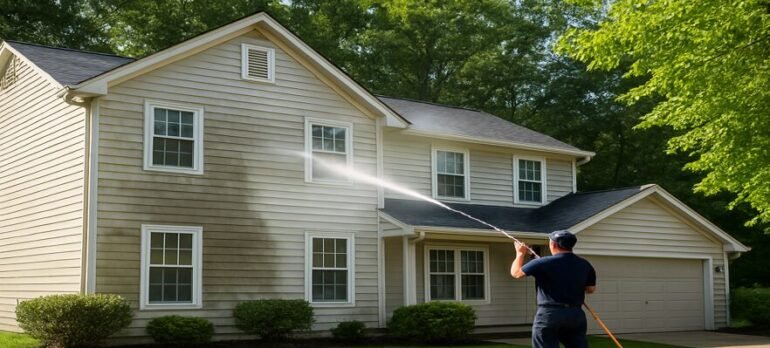
Your home’s exterior faces constant exposure to changing weather, dust, and organic debris. Whether it’s sunshine one day and rain the next, dirt, algae, and mould can build up quickly, especially if your home is shaded or surrounded by trees. So, how often should you wash your house?
The answer depends on several key factors, such as your environment, building materials, and the time of year. Here’s a complete guide to help you plan regular house washing and avoid expensive maintenance issues.
How Climate Affects House Washing Frequency
In humid or rainy areas, it’s common for moss, algae, and mildew to grow on exterior surfaces. These organisms can stain paint, damage cladding, and even shorten the lifespan of your roof. Moss buildup alone has been shown to reduce roof durability by up to 50%.
If you live in a region with regular rainfall or near the coast, you may need to clean your home more often. In such areas, roof cleaning becomes especially important to prevent leaks and preserve structural health.
Tree Coverage and Its Impact on Cleaning Needs
If your home is surrounded by trees, you’re probably familiar with falling leaves, sap, and twigs sticking to your roof and walls. These materials hold moisture, which can lead to faster mould growth and staining. In heavily shaded areas, washing your house every 6 to 12 months is often recommended. It’s also a good idea to pair this with gutter cleaning to prevent blockages and water overflow that can damage foundations.
Why Exterior Material Type Matters
The material your house is made of plays a big role in how often it needs to be washed. Here are a few common materials and how they respond to dirt and moisture:
- Wood siding tends to absorb moisture and can show wear quickly
- Brick and concrete are more durable but may develop stains over time
- Painted and vinyl surfaces resist dirt longer but still collect mildew in shady spots
If your home features delicate materials like painted wood or timber cladding, using soft washing methods is a safer and more eco-friendly choice. This approach is gentle yet effective at removing grime without damaging the surface.
Don’t Forget the Roof
Many homeowners focus on walls and siding, but the roof often suffers the most from weather and debris. Moss, algae, and leaves can clog valleys, wear down shingles, and eventually lead to leaks. Ideally, roofs should be cleaned every 12 to 24 months, depending on the environment and exposure. Some also choose to include roof repair services if there’s visible damage during the cleaning process.
Seasonal House Washing: Best Times to Clean
The best time to wash your home is right after a long, wet winter or rainy season. This is when mildew and grime have had the most time to develop, especially in shaded areas.
Spring or early summer is ideal. It not only refreshes the exterior but also prepares your home for the sunny season ahead. Many people also take this opportunity to schedule deck and fence cleaning for a full outdoor refresh.
Warning Signs Your House Needs Cleaning Now
Instead of waiting for a specific date, keep an eye out for visible signs like:
- Green algae streaks
- Black mould spots
- Dust and dirt buildup
- Water stains on interior ceilings (a potential sign of moss-damaged roofing)
These symptoms mean your house may need cleaning sooner than expected. Acting early can prevent more serious problems and protect your investment.
Conclusion
House washing isn’t just about appearance — it’s an important part of protecting your home from long-term damage. Factors like local weather, tree coverage, and exterior materials all play a role in how often you should clean. Regular maintenance, especially after rainy seasons or when signs of mould appear, helps extend the life of your paint, roof, and walls.
Contact Quik Solutions today to book a professional house wash and keep your home clean, healthy, and protected all year round.


